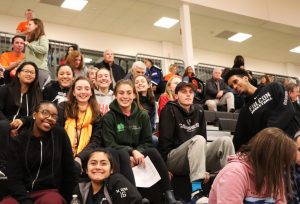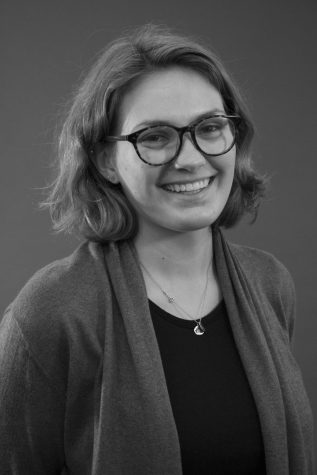Athletic Department Progresses, Looks to Improve
January 30, 2018
In June, 2017, the Register Forum reported on a letter written by female athletes at CRLS listing complaints about the treatment of female athletes at the school. Seven months later, the Register Forum sat down with Athletic Director Tom Arria and student-athletes to discuss athletics at CRLS this year.
New Practices this School Year
This school year, Mr. Arria has introduced two kinds of meetings to improve communication in CRLS athletics. Student-athlete leaders meet monthly during Community Meeting (CM), and there are open meetings for students to talk once a month after school about athletics at CRLS. However, regarding these open meetings, Mr. Arria commented, “I’ve yet to have any students attend to, kind of, bring up concerns.”
Mr. Arria also said that he talked to female athletes about creating a female athletes’ council, but students have not reached out to him to start the council. “One of the things that we had talked about as coaches [after the letter in June] is what types of things can we do to garner [fan] support and bring back pride and make sure that girls coming up from those younger ages know that involvement in athletics is an important thing and something to be proud of, and it’s something to rally support around,” said Mr. Arria. He thinks one thing the female athletes’ council could do is help with connecting high school athletes with elementary or middle school female athletes.
“I’ve mapped out these open student meetings that no one’s attended, offered the idea of a female student-athlete council which no one has followed up with me on—so you know, I’m trying to create opportunities to open the door for these things, but we need some student buy-in, obviously,” said Mr. Arria.
Co-captain of the girls soccer team Danielle Reeves ’18 said she hadn’t heard about creating a female athletes’ council and thinks the idea might have been shared with female athletes who graduated last year. “It’s kind of hard to implement that if the people still here didn’t know about it,” she said. However, Reeves thinks reaching out to younger athletes is important: “I think going to them and telling them what it’s like [to play a sport at Rindge] and just encouraging them to continue to play—especially for girls—would be a good, helpful idea.”
Senior Emma Andrew rows for the crew team at CRLS and is co-president of the school’s feminism club, Club 1. Andrew has attended the CM meetings for student-athletes and commented that Mr. Arria has “definitely been pushing for athlete activism.” She added, “Something that he’s been trying to push us to do is to come up with concrete ideas, concrete things that we can do to better our teams and the athletic environment at our school.” Reeves commented that at the CM meetings, athletes can raise concerns with the athletic director in “face-to-face conversations” in addition to talking with other student-athletes and promoting their events. Reeves also said that she thinks this year’s players “took it upon themselves to promote [their] games” and advocate for themselves more.
Andrew said she had not heard about creating a female athletes’ council, but that this year’s powderpuff football game is an example of concrete action taken by students “to provide a space for women in a sport like football that is so heavily dominated by men.” The game was organized by Student Government, and Club 1 helped promote the game and wrote a statement describing the reasons for the game.

Pictured: Fans at an away girls volleyball game this past fall.
Lingering Concerns
Although athletes such as Andrew and Reeves feel that some progress is being made, others remain frustrated by their experiences on CRLS sports teams. Junior Isabella Andrade, who has played varsity soccer since her freshman year, commented that fan turnout at games is still a concern for the girls soccer team, which made it to the state tournament for the second time in a row this year but had few CRLS supporters at their game and no fan bus.
Regarding turnout at games, Mr. Arria commented, “Obviously I want every team to feel supported and have fans there. I would like to be able to snap my fingers and say, ‘Hey, your fan bus is full.’ Or get on the intercom or send an email and say, ‘Everybody come to the game.’ It’s just not realistic. The only way people are going to come is if the team itself, all of our teams, … work by talking about it constantly in their peer groups.”
Andrade said she had not heard about the idea of a female athletes’ council, commenting, “I’ve never heard that idea, but I feel like that would be a good idea.” She added, “I feel like one person trying to fix the problem, like [Mr. Arria]—it’s just not good enough. Because he’s trying to make sure everyone’s happy, but I don’t think it’s as successful as he hoped.” She thinks that a female athletes’ council could “definitely” help with communication.
Continuing to Improve CRLS Athletics
Some athletes also emphasized a need for less competitive athletic opportunities at the school. Andrew commented that Club 1 has talked about “creating intramural games and pick-up games to make CRLS sports less intimidating [and] less intense,” especially for female students exploring a sport for the first time.
Junior Jonathan Matsko, a member of the CRLS swim team, agrees that less competitive sports would benefit students at CRLS. Matsko commented that teams which don’t cut members, such as swimming, can still be significant physical and time commitments. “I think there need to be easier opportunities for people who aren’t typically into athletics to join a team and feel comfortable trying something new,” he said.
Matsko, who tried CRLS crew before joining the swim team, said he joined swimming for P.E. credit originally, “but this year it was just to kind of stay in shape and to just show school spirit and be involved in the community.” Reeves commented, “Most of my closest friends are from my team,” and Andrew also emphasized the social aspect of school athletics, saying, “When looking to improve the sports environment at CRLS, it’s also important to take into account the social aspect of it.”
Talking about building up each sports program at CRLS, Mr. Arria noted, “It’s definitely going to take some time. It’s not just saying, ‘Hey, we don’t feel like we’re supported,’ or, ‘People don’t come to our games,’ and then people are going to come automatically.”
“There’s got to be a plan around it … There’s got to be some things that we do to make sure that we’re creating or drumming up that support. And, to be honest with you, I wouldn’t be able to do it by myself anyway,” he continued, “But if we come up with a campaign on it—if we do some different things and have some different exercises—then I’m all on board to aid, help, and support however I can.”
This piece also appears in our January print edition.










